What are Milia?
Milia are small, white, or yellowish bumps that appear on the skin. They are often found on the face, especially around the eyes, cheeks, and nose. Milia are caused by a buildup of keratin, a protein found in the skin, hair, and nails. When keratin becomes trapped under the skin, it forms a small cyst.
Types of Milia
There are two main types of milia: primary and secondary.
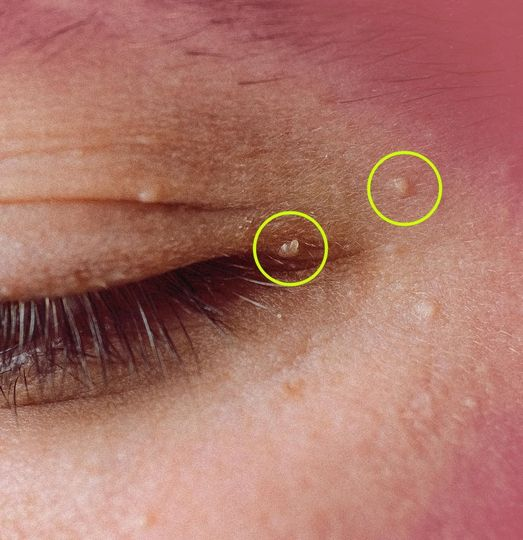
Primary Milia
Primary milia are the most common type. They can affect children and adults, but they often develop at birth. Primary milia typically don’t cause any symptoms and often disappear on their own within the first few months of life. There are several types of primary milia:
- Congenital Milia: These are present at birth and are often found on the nose, scalp, face, upper trunk, and inside the mouth.
- Benign Primary Milia of Children and Adults: These develop spontaneously and can appear on the eyelids, cheeks, forehead, and genital area.
- Milia en Plaque: This condition involves multiple milia appearing together in a flat, raised patch with a defined border.
- Multiple Eruptive Milia: This type develops suddenly and rapidly over weeks or months.
Secondary Milia
Secondary milia usually affect older children and adults and are often caused by:
- Medication: Chronic topical steroid use can lead to milia.
- Medical Conditions: Milia can occur alongside skin conditions like epidermolysis bullosa.
- Trauma: Injuries like burns, blisters, skin resurfacing procedures, and excessive sun exposure can trigger secondary milia.
How to Get Rid of Milia
Milia typically resolve on their own without treatment, but there are some things you can do to help speed up the process.
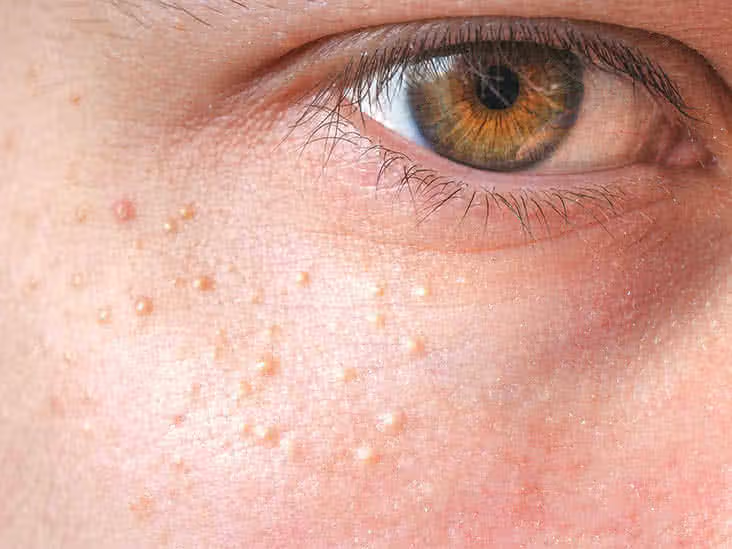
Home Remedies for Milia
While home remedies may not always be effective, here are some options:
- Clean the Affected Area Daily: Use a mild soap to prevent skin irritation.
- Steam Open the Pores: Take a hot shower or sit in a steamy bathroom.
- Exfoliate Regularly: Gentle exfoliation can help remove dead skin cells and unclog pores. However, avoid over-exfoliating, as this can irritate the skin.
- Use Over-the-Counter (OTC) Options: Try OTC topical retinoids like Differin or chemical facial peels containing glycolic or salicylic acid.
Important Note: Always consult with a dermatologist before trying any home remedies, as some may not be suitable for your skin type or milia.
Can You Pop Milia?
The answer is a resounding NO! Popping or squeezing milia will not remove them and can damage or scar your skin. It’s also best to avoid poking or picking at milia, as this increases the risk of infection and scarring.
Professional Treatment Options for Milia
If home remedies don’t work, a dermatologist may recommend professional treatment options. These may carry a risk of scarring:
- Manual Extraction (De-roofing): A dermatologist uses a sterile needle or blade to make a tiny opening in the milia and then pushes out the keratin plug. Never attempt this at home.
- Prescription Medications: A dermatologist may prescribe prescription-strength topical retinoids or oral minocycline (an antibiotic).
- Other Procedures: These include:
- Curettage: The area is numbed, the milia are removed, and the skin is sealed with a hot wire.
- Cryotherapy: Extreme cold is used to freeze the milia.
- Diathermy: Extreme heat is used to remove the milia.
- Laser Surgery: A laser is used to remove the milia.
- Dermabrasion: The top layer of skin is removed to treat the milia.
What Causes Milia?
The causes of milia can be grouped into primary and secondary:
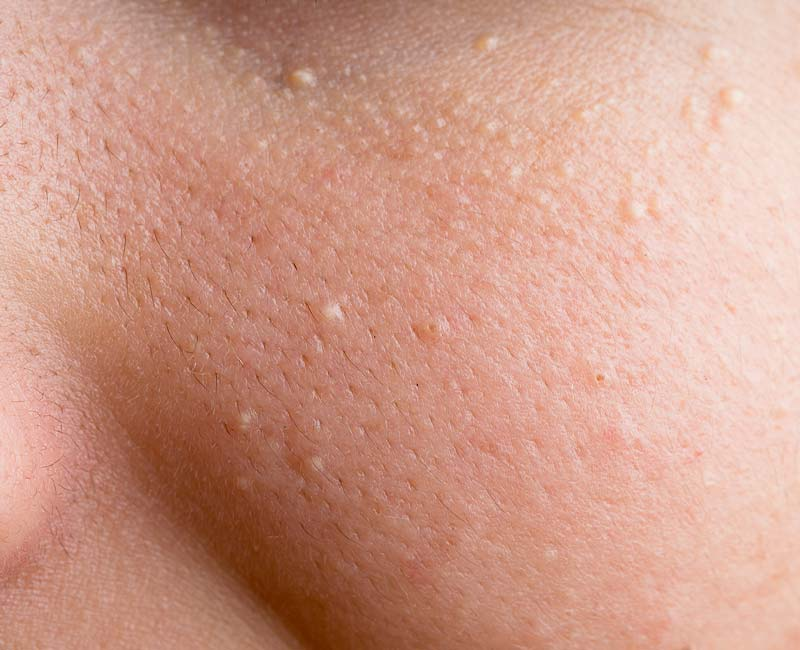
Primary Milia Causes
Primary milia are often caused by a combination of factors, including:
- Genetics: Some people are genetically predisposed to developing milia.
- Skin Type: People with dry or sensitive skin may be more prone to milia.
- Sun Exposure: Excessive sun exposure can damage the skin and lead to milia.
- Certain Medications: Some medications, like topical steroids, can cause milia.
Secondary Milia Causes
Secondary milia are often caused by:
- Trauma: Burns, blisters, skin resurfacing procedures, and excessive sun exposure can trigger secondary milia.
- Medical Conditions: Certain skin conditions, like epidermolysis bullosa, can cause secondary milia.
- Medications: Chronic topical steroid use can lead to secondary milia.
Preventing Milia
While you can’t always prevent milia, here are some tips to minimize your risk:
- Wash Your Face Twice a Day: Use a gentle cleanser to remove dirt, oil, and makeup.
- Exfoliate 2-3 Times a Week: Use a gentle exfoliating scrub or chemical exfoliant to remove dead skin cells.
- Use Sunscreen Daily: Apply a broad-spectrum sunscreen with an SPF of 30 or higher every day, even on cloudy days.
- Avoid Harsh Products: Avoid using harsh soaps, scrubs, or other products that can irritate your skin.
Should You Be Concerned About Milia?
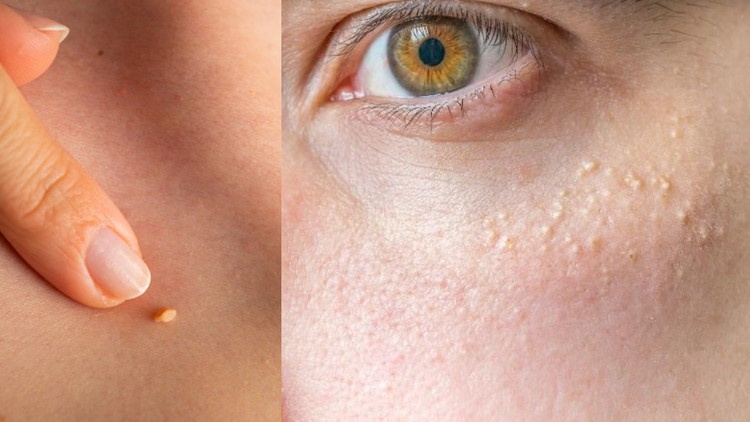
Milia are generally considered benign and don’t pose any health risks. However, they can be cosmetically bothersome. If you’re concerned about milia, it’s always best to consult with a dermatologist.
Can Milia Get Infected?
Milia can become infected if you pick, scratch, or try to pop them. If you notice any signs of infection, such as redness, swelling, pain, or pus, see a dermatologist immediately.
When to See a Dermatologist
If your milia don’t resolve on their own or if you’re concerned about their appearance, see a dermatologist. They can diagnose the cause of your milia and recommend the best treatment options.
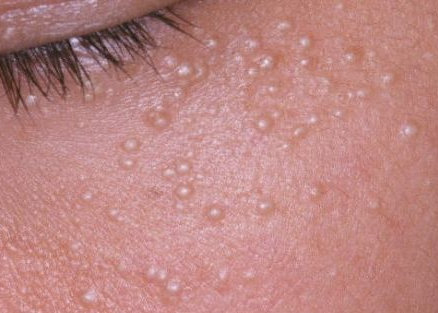
Milia vs. Other Skin Conditions
It’s important to see a dermatologist to get a proper diagnosis, as milia can be confused with other skin conditions, including:
- Comedones (Blackheads and Whiteheads): These are caused by clogged pores, while milia are caused by trapped keratin.
- Miliaria (Heat Rash): This is a rash caused by sweat trapped under the skin, while milia are caused by trapped keratin.
- Other Types of Cysts: There are many types of cysts, and a dermatologist can help differentiate them from milia.
The outlook for people with milia is generally good. Many cases resolve on their own without treatment. However, secondary milia may require medical intervention.


